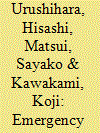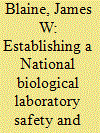|
|
|
Sort Order |
|
|
|
Items / Page
|
|
|
|
|
|
|
| Srl | Item |
| 1 |
ID:
126104


|
|
|
|
|
| Publication |
2012.
|
| Summary/Abstract |
In response to the 2009 H1N1 influenza pandemic, the governments of Japan and the United States for the first time authorized the emergency use of unapproved drugs. In this article, we comprehensively review the different regulatory approaches of Japan and the United States, countries with advanced regulatory and healthcare systems, to emergency authorization of the use of medical products as a countermeasure to public health emergencies. We outline the legal system, range of targeted products, requirements for the application dossier, legal stance for authorization, product availability, and termination of the Japanese Emergency Approval (EA), and we compare characteristics with those of the US Emergency Use Authorization (EUA). We also review the actual cases of these 2009 emergency authorizations. The Japanese EA importation of novel H1N1 influenza vaccines with adjuvant is presented, with lessons learned, and contrasted with the US EUA of peramivir.
|
|
|
|
|
|
|
|
|
|
|
|
|
|
|
|
| 2 |
ID:
126123


|
|
|
|
|
| Publication |
2012.
|
| Summary/Abstract |
The growing concern over the potential use of biological agents as weapons and the continuing work of the Biological Weapons Convention has promoted an interest in establishing national biological laboratory biosafety and biosecurity monitoring programs. The challenges and issues that should be considered by governments, or organizations, embarking on the creation of a biological laboratory biosafety and biosecurity monitoring program are discussed in this article. The discussion focuses on the following questions: Is there critical infrastructure support available? What should be the program focus? Who should be monitored? Who should do the monitoring? How extensive should the monitoring be? What standards and requirements should be used? What are the consequences if a laboratory does not meet the requirements or is not willing to comply? Would the program achieve the results intended? What are the program costs? The success of a monitoring program can depend on how the government, or organization, responds to these questions.
|
|
|
|
|
|
|
|
|
|
|
|
|
|
|
|
| 3 |
ID:
126117


|
|
|
|
|
| Publication |
2012.
|
| Summary/Abstract |
A deliberate attack involving chemical, biological, radiological, or nuclear (CBRN) material has the potential to cause substantial fear among the public. This presents problems for communicators, who will need to provide information quickly after an attack while ensuring that their messages are easily understood and likely to be attended to by members of the public. Identifying in advance what people would want to know, where they would get information from, and how messages should be presented might allow communicators to ensure that their messages have the best chance of having their desired effect. In this review, we identified all peer-reviewed studies that have assessed communication strategies or information needs using hypothetical CBRN scenarios or in actual CBRN incidents. We identified 33 relevant studies. Their results support existing psychological models of why people engage in health protective behaviors, with information about the severity of the incident, the likelihood of being exposed, the efficacy and costs or risks of recommended behaviors, and the ability of individuals to perform recommended behaviors being sought by the public. Trust plays a crucial role in ensuring that people attend to messages. Finally, while a large variety of spokespeople and sources were identified as being turned to in the event of an incident, the use of multiple information sources was also common, affirming the importance of communicating a consistent message through multiple channels. Further research is required to extend these predominantly US-based findings to other countries and to confirm the findings of research using hypothetical scenarios.
|
|
|
|
|
|
|
|
|
|
|
|
|
|
|
|
| 4 |
ID:
126092


|
|
|
|
|
| Publication |
2012.
|
| Summary/Abstract |
This article summarizes major points from a newly released guide published online by the Office of the Assistant Secretary for Preparedness and Response (ASPR). The article reviews basic principles about radiation and its measurement, short-term and long-term effects of radiation, and medical countermeasures as well as essential information about how to prepare for and respond to a nuclear detonation. A link is provided to the manual itself, which in turn is heavily referenced for readers who wish to have more
|
|
|
|
|
|
|
|
|
|
|
|
|
|
|
|
| 5 |
ID:
126087


|
|
|
|
|
| Publication |
2012.
|
| Summary/Abstract |
Lesson learned from large scale nuclear disasters have historically inspired changes to emergency preparedness. The 1979 nuclear accident at three mile Island informed the formation of the federal emergency management Agency (FEMA), fundamentally changing the federal government`s approach to preparedness and response and augmenting US nuclear emergency preparedness. The 1986 accident at the Chernobyl nuclear power plant in the former Soviet Union prompted an era of international cooperation in nuclear safety and radiological protection that continues to this day. Likewise, the 2011 meltdown at the Fukushima Daiichi nuclear power plant in Japan after the Great East Japan Earthquake offers many lessons for US radiological emergency preparedness.
|
|
|
|
|
|
|
|
|
|
|
|
|
|
|
|
| 6 |
ID:
126125


|
|
|
|
|
| Publication |
2012.
|
| Summary/Abstract |
The 2001 anthrax attacks emphasized the need to develop outreach that would more effectively support racial/ethnic minority populations during a bioterrorism incident. Given the importance of antibiotic prophylaxis in a future anthrax attack, it should be a priority to better support racial/ethnic minorities in mass dispensing programs. To examine the needs and perspectives of racial/ethnic minorities, this study used a nationally representative poll of 1,852 adults, including 1,240 whites, 261 African Americans, and 282 Hispanics. The poll examined public reactions to a ''worst-case scenario'' in which cases of inhalation anthrax are discovered without an identified source and the entire population of a city or town is asked to receive antibiotic prophylaxis within 48 hours. Findings suggest willingness across all racial/ethnic groups to comply with recommendations to seek prophylaxis at dispensing sites. However, findings also indicate possible barriers for racial/ethnic minorities, including greater concern about pill safety and multiple attacks as well as lesser knowledge about inhalation anthrax. Across all racial/ethnic groups, roughly half would prefer to receive antibiotics at mass dispensing sites rather than through the US Postal Service. People in racial/ethnic minority groups were more likely to say this preference stems from a desire to speak with staff or to exchange medication formulation or type. Findings suggest the need for tailored outreach to racial/ethnic minorities through, for example, emphasis on key messages and enhanced understandability in communications, increased staff for answering questions in relevant dispensing sites, and long-term trust building with racial/ethnic minority communities.
|
|
|
|
|
|
|
|
|
|
|
|
|
|
|
|
|
|
|
|
|